David B. Levy's Blog, page 2
January 17, 2012
Animation Career Round Up
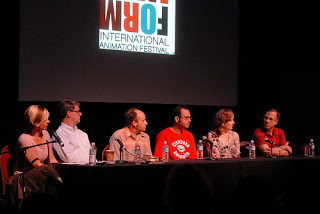 *a snapshot of a panel called "Job or No Job" from the 2008 Platform Animation Festival in Portland, Oregon. Left to right: Heather Kenyon (moderator), and panelists Fred Seibert, Jason McHugh, me, Debra Blanchard, and Frank Gladstone.
*a snapshot of a panel called "Job or No Job" from the 2008 Platform Animation Festival in Portland, Oregon. Left to right: Heather Kenyon (moderator), and panelists Fred Seibert, Jason McHugh, me, Debra Blanchard, and Frank Gladstone.A very nice (and talented) former student recently ran into trouble finding work after his long-term job ended. Hearing his story brought back memories of my first animation layoff some 15 years ago. Lay offs are like rights of passage in this industry. Before they come along we work under the illusion of stability and consistency. My first lay off forever changed me, making me realize I was responsible for my own experience in this industry.
To try and help my former student, I first rounded up 10 links to past Animondays entries dealing with the subjects of finding work, keeping a job, and building a healthy and rewarding career in this industry. This is hard-won information, based on my experiences (mistakes and all) along with observations on others. Since it could be of use to others as well, I'm using this blog post to present those links.
Even with ten essays, this is far from the whole story, so feel free to add your own additional links in the comments. It might be fun to follow this next week with a round up of similar links from Richard O' Connor and Mark Mayerson, who have also written extensively on the subject from their own areas of expertise.
On the role and importance of relationships to your career.
On the difference between a job-to-job existence vrs. having a career plan.
On the difficulty of breaking in to the business.
On techniques you can use to give yourself an edge in the market place.
On avoiding bad mentors and bad advice in the workplace.
On what's missing from unsuccessful job hunts.
On surviving downtime.
On the role of staying connected and staying in touch to ensure continued employment.
On the importance of being able to juggle all the aspects that make up a successful long-term career in animation.
On how your non-animation related work can teach you lessons that are also applicable to this industry.
Published on January 17, 2012 17:40
January 14, 2012
Booking
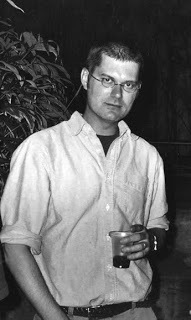 The one and only Mo Willems, animation superstar turned amazing children's book author, caught in a snapshot while attending an ASIFA-East festival last decade.
The one and only Mo Willems, animation superstar turned amazing children's book author, caught in a snapshot while attending an ASIFA-East festival last decade.Over the years I've flirted with the idea of trying to develop as a children's book author. Starting in the late 90s, I illustrated a steady stream of books for Simon & Schuster, Scholastic, and Golden Books. These were all Blue's Clues titles. This opportunity came from working on the series that spawned them. All I had to do, initially, was take a test to get on the approved list of illustrators. After that you just waited for the phone to ring.
Starting around 2004, I wrote a half dozen original manuscripts of my own book ideas, created some concept art, and submitted to an agent or two and the odd publisher. Despite some interest and encouragement, no deals were forthcoming. Then, one day I asked my friend, Mo Willems, for advice. He said that putting a viable children's book together is much more work than people think, and advised that it's absolutely necessary to rough out the entire book before approaching an agent.
Unlike the world of pitching animated series ideas, when it comes to children's books, you absolutely need an agent. Publishers only want to look at books that come through agents, knowing that agents only represent books/authors that have merit and sales potential. Agents act as the buffer zone for publishers. They fend off all the "unsuitable" books that publishers don't have to see.
Once I was armed with Mo's good advice I can't say that followed it. Instead, I tried another handful of book pitches in my own half-lazy way with no success. Up until six months ago I would have said that my so-called attempts at cracking the world of children's books were over. But, half the fun of a career is not being able to predict what's ahead.
While making an original animated series pitch with a couple of partners, we enlisted a wonderful comedienne/writer/actress to voice one of our characters. I loved her voice and she loved our project (the latter of which comes in handy when you're asking an established talent to work on spec). Half way through our production, she asked me if I would be willing to do some spec work for her, illustrating a children's book she wanted to write. She presented two raw ideas and I picked the one I was interested in. She wrote a few drafts and I designed the characters.
A couple of months drifted by until I could jump back on the book project, but when I did I remembered Mo's advice: "rough out the entire book before approaching an agent."
So, I decided to rough out the entire 32 page book and take 5 or so spreads to full finished color. Laying out the book, figuring out the page flow, type design, etc., has been a blast. I see now what Mo meant. The book just isn't there until you go through that process. Sure, there's the "voice" of the author's writing, but the other "voice" is how that story unfolds into a page-by-page visual experience. Why would an agent or publisher "get it" without you having done that work?
My experience finally utilizing Mo's wisdom reminds me how often we go around collecting good advice, but so seldom use it. Still, better late than never.
Published on January 14, 2012 05:20
January 7, 2012
Guest Speakers

My favorite class to teach is the animation career strategies class at SVA, which is titled Animation Promotion/PR (Public Relations). As I've mentioned before, when I was a student at SVA, Linda Simensky taught this class, where she brought in a who's who of local animation talent to share the ups and downs of working-in-animation.
It's been my pleasure to keep that same tradition going by bringing in talented guest speakers over the years such as PES, Patrick Smith, Candy Kugel, Mo Willems, Tom Warburton, Xeth Feinberg, Tina Moglia, Ray Kosarin, Allan Neuwirth, Debra Solomon, John R. Dilworth, Otis Brayboy, Ian Jones Quartey, Jake Armstrong, and many others. My rule for guest speakers is that they must have unique experiences different from my own (since the students are already stuck with me), and that each speaker represent a specific career path.
The 15-week course spun off into my first book in 2006, ensuring the information gathered has reached beyond my classroom. But, the best thing for me is how teaching this class gives me the privilege of meeting and connecting with a new wave of talent each year, and how through the students' questions and guest speakers' advice, I have a chance to learn something new too.
At the end of the fall 2011 term of my class, I compiled a visiting guest speaker list, so I could summarize the wisdom offered by each one. As a way to kick in 2012, I thought it would be fun to post this list below. Best wishes on your career in animation in the new year!
Eileen Kohlhepp- stop motion animator –
As a stop-motion animator (her current gig is animating for Henry Selick on his new feature!) she's had to move around a lot and work in different cities, so she relies on staying in touch with people to help ensure future work. With each booking she updates her roster of clients as to her schedule––what she's working on, when she'll finish, etc. Giving former clients such updates has made it easier from them to hire her. Not a bad strategy.
Dan Meth- web animator-
Anyone who earns a living writing/directing/and producing his own animated cartoons deserves our attention and admiration, so I'm always happy to have Dan visit my class. This semester, he presented a power point lecture that included a slide displaying the logos for Tumblr, Facebook, YouTube, LinkedIn, and Vimeo with a headline above saying "Don't Fight These." Dan's point is that social media as a powerful tool for today's creative people, and one that has allowed him to spread his brand across the airwaves.
Kevin Maher- writer-
This human ball of creative energy, whom I've written about before here, told us that before taking on any freelance job he evaluates it based on how well it scores on a series of factors, giving it a 1-5 score on: money, creative satisfaction, ability to lead to new contacts, how limited an impact it will have on family time, and if it represents a clear step forward in his career. For Kevin to take on a gig it has to score at an 18 or higher.
Emily Campbell- Entertainment Lawyer-
"Be your own business agent," advised entertainment lawyer Emily Campbell. She cautioned that animation artists that run their own studio businesses should never entrust the job of business manager to anyone but themselves. The thinking behind this is that nobody but the owner/operator knows what money is coming in and out and how to properly manage it. Plus she added that many times when people entrust their books to someone else it results in getting ripped off.
ila Abramson- Owner/recruiter of Ispy Recruiting-
North America's top expert in how to prepare yourself and stay prepared as an animation industry professional, ila explained how your resume/reel/portfolio, etc. are always in process, for your whole career. As a survival skill, animation artists must be in the habit of constantly updating their work to keep it current. ila told many cautionary tales of artists that didn't do so and once their jobs ended (or the studios that employed them closed down), they found it impossible to retrieve samples of their work.
Liz Artinian- BG and color supervisor "The Venture Bros." and founder of 2Art for TV-
Speaking to students as the next generation to enter the workforce, Liz stressed the importance of being professional in the work place and not to make the mistake of creating another "high school" environment on the job. She gave examples how holding a poor or immature attitude holds back achievement in a collaborative atmosphere of an animation studio.
Rick Ritter- storyboard artist on Nick Jr's Team Umizoomi-
Rick, through his dead pan humor, explained that although he hadn't trained to work in the animation industry, he was able to pick up much of his skills as a storyboard artist by learning from everyone around him––picking and choosing from the best of his co-workers skills.
Pilar Newton- home studio owner/operator of PilarToons, LLC-
In her naturally enthusiastic delivery, Pilar reminded the students not to forget that they're artists and not just defined by animation-specific jobs that they get or don't get. "You can work in other areas, such as silk screen, graphic design, illustration, etc…," she said.
Tim and Mike Rauch -Indie Directing & Producing team-
If the job you want doesn't exist, invent it and put in the sweat equity to make it happen––so was the example provided by the Rauch Brothers. In short, there was no studio, no job for which to apply to that would allow them to make powerful and gripping animated documentaries full of humanity. So, over a painstaking three-year period they tapped into their connections, developed their creative approach to the medium, proved what they could do by executing three fantastic sample films, and (all the while) sacrificing financially until all the planets aligned.
Fred Seibert- Founder and Exec Producer of Frederator & Media Entrepreneur-
If you know Fred at all, you can guess that he had the students' attention from his first word, telling us truths such as buyers (networks, media companies, etc.) only pay attention to people who make things (films, comics, etc.) because these are the people that have something to say/sell. On the entrepreneurial side, Fred cautioned that his plans that failed were always the ones that were rushed and not properly thought through.
Published on January 07, 2012 09:55
January 2, 2012
Animondays Interview: Linda Simensky -part II
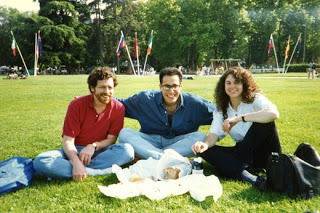 *I'm a sucker for photos filled with my animation heroes. Here's a photo via Michael Sporn from a 2007 post on Annecy. Left to right are Sporn, John R. Dilworth, and Linda Simensky in 1992.
*I'm a sucker for photos filled with my animation heroes. Here's a photo via Michael Sporn from a 2007 post on Annecy. Left to right are Sporn, John R. Dilworth, and Linda Simensky in 1992.Happy New Year to all! As my first post of 2012 I'm happy to present the conclusion to my interview with the PBS Kids VP of Children's Programming, Linda Simensky.
For all those pitching in 2012, best of luck to you. Enjoy the experience, get as much as you can out of it, and be open to other measures of success. You may not sell your project out of the gate, but you'll be on the road to building better communication/storytelling skills, and make important new relationships with producers and development execs that could lead to job opportunities (if not a deal on your creations down the line).
Linda's answers are straight-forward, practical, and should help you on your way. Good luck!
13-How useful have pitching extras (such as a bit of finished animation, voice or song track) been to you in a typical pitch meeting?
Seeing a demo of the animation can sometimes help show us more about the idea. There have been times, such as in the WordGirl pitch, where Soup 2 Nuts came in with a very funny piece of animation, and we all fell in love with it. On the other hand, we've seen a number of horrible demos that have pretty much killed the projects for us. As for other extras, such as theme songs or voice samples, if we already like the idea for the show, these are often interesting to see, but I can't think of time when the extras made us change our minds about an idea.
14-How much time should a creator give a network to get back to them with a verdict after a pitch meeting?
It varies, but I'd say that it often takes a fair amount of time. You can get a rejection fairly quickly but contructive feedback takes time. If several people are going to look at an idea, and someone is going to put some notes together, it can take a while. Also, the higher up the executive is in the company, the more time it will take to hear back from them.
I tend to look at projects in relation to each other, and that adds time to the process.
Since our department does more than just development, sometimes production takes precedence over development.
It is okay to call or email and check on the status of your project, as long as you don't start to nag. You might get a faster answer if you pose your question as "I am curious to know what you thought," as opposed to "Please give me an answer as soon as possible."
I am usually swamped at work to begin with, and there's usually something going in production on that needs immediate attention.
15-Is the Paper Development deal (where a network options a project and commissions more scripts, designs, or storyboards) the standard first deal in your development process, or do some projects go right to pilot or series? If so, why?
In past jobs, there were always the development deals, followed by pilots. At PBS, we have a slightly different process, and the experience for each show is different. The producer and the producer's experience, the kind of show, and what the show seems to need all determine the approach we will take with that property. Some go right to series, some start with a set of shorts or a Web site, some go to pilot, and some may go direct to broadband, an option we are currently in the midst of designing.
If a series is pitched by someone we are already working with, we may determine we are comfortable with that producer and move ahead to a series without a pilot. But when we have questions about a show or a creator, we might ask for a pilot or some further development to answer those questions.
16- What amount of each year's green lit projects are initiated by or that involved celebrities as a selling point?
None at present, but people often end up casting more famous voices. PBS seems to attract a number of actors who are interested in being connected with PBS, either for their kids or because of their appreciation of PBS from their own childhoods.
There hasn't been a point, either, where we've felt that we should pick up a show just because it featured a celebrity. It all comes down to the strength of the show, with our without the celebrity. After all, the chance of that celebrity dropping out of the show for some other obligation is pretty high, so a show needs to work on concept alone.
17- What is your opinion of shorts programs (such as What a Cartoon! at CN, and Random Cartoons from Frederator/Nick)? What are the pros/cons of such programs?
These types of programs are great for giving emerging artists the chance to make a short and get experience. The odds of getting a series through these sorts of programs are pretty small, though, probably smaller than if you just pitched to the network.
18-Besides looking at pitches, what are some of the other duties a network development executive juggles?
At PBS, there is no member of the kids programming department who handles only development. We oversee all of kids programming, so we handle program strategy and scheduling, development, and current series. In addition, we work closely with other departments, so we are involved with Interactive, Marketing and Branding, Business Affairs, and several aspects of management at different levels. We speak at and arrange a number of meetings each year with the PBS stations, as well. We're always in meetings about any number of topics.
19- How open are you to re-looking at a previously pitched (and rejected) project, assuming that the creator has made a large amount of changes and improvement?
Sure. We have looked at many projects at several different stages. I can think of several projects that came to us that weren't what we were looking for. After numerous discussions and changes, a few have ended up in our commissioning rounds. I think it is rare for an idea to come in fully figured out and fitting perfectly into our lineup. Everything usually requires some feedback.
For some projects, though, if they aren't working after a few tries, it's usually best to move on.
20- How much experience should a would-be creator have before they are ready for their own pilot or series? And where should they best get that experience?
At PBS, producers and creators must have series experience, and preferably experience in kids educational programming, as well. People starting out should want to have experience -- I would imagine it is fairly daunting to be running a 40-episode first season order with no background in producing. Given this huge level of responsibility and how much freedom a producer gets, I would prefer to work with people who have experience producing a series.
21-Any advice for new comers to pitching on how to best manage & cope with the emotional rollercoaster inherent in the pitching process?
Go into the process expecting to hear "no" most of the time. Use your experiences to learn more about pitching and more about the networks you are pitching to. Try to get as much experience as possible working on other shows.
22- How, if at all, do you think new platforms for animation such as on smart phones, ipads and the internet will change the future of the network development process? *NOTE: this Q & A dates from 2009.
At PBS, new platforms have already changed the development process from creating a series to to creating a multi-platform property. Certainly now there are more opportunities to get ideas seen in other media, and more opportunities to get experience. Eventually, there will be a number of creators who will be able to say they got their start on the web or on cell phones, but at this time, there aren't that many. There is something about those formats that emphasizes quick laughs over character development and storytelling, which are still the cornerstones of TV series.
23- How much effort have you made in building relationships and friendships with would be creators, and how important is it to do so?
I wouldn't call it an effort, as much as a positive side effect of working in the kids TV and animation industries. At this point, many of my friends are from the industry and we've become friends because we are interested in the same things. I wouldn't say I have attempted to befriend everyone I've worked with, but many of us spend a fair amount of time together, either on the phone or in meetings or at meals, and we've gotten to know each other pretty well. These relationships help because they allow us to be honest with each other. But these sorts of work friendships have to happen naturally.
24- How much effort do you put towards monitoring trends, fads, and other factors that might effect the sellability of shows? If so, how does this effect your network's development process?
At PBS, we do focus on different areas each year, but the changing directions tend to have more to do with what we feel we need to close programming gaps. We notice fads, but we don't have to do anything about them. As far as trends go, we've always been more interested in creating trends than following them. It's hard not to notice if several people are doing similar shows, but there's never any pressure to follow anyone else.
25-Can you estimate, in a year, how many pitches your network receives, options, and picks for pilot production?
We probably receive somewhere between 200 and 300 pitches per year. Only about 20% meet our criteria and get serious consideration, such as feedback. About 10-12 make it to the two final greenlighting rounds, and two to three shows per year go to series.
Published on January 02, 2012 05:28
December 22, 2011
Animondays Interview: Linda Simensky -part I
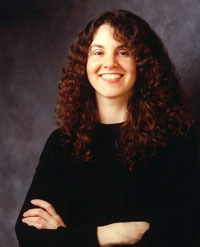
Pitching is on my mind these days because I'm prepping (along with my partners, The Levinson bros.) an original 5 min self-produced pilot and mini bible for use in a major round of pitching in January and February. Pitching is not for everyone, nor does it line up with everyone's goals for what they want to achieve or explore in the art and industry of animation. But, those that are curious about this interesting area may find this post useful.
Linda Simensky, PBS Kids VP of Children's Programming, was the first animation development executive I ever met. Level-headed, funny, and an expert in her field, she's been a trusted friend and mentor to me for almost two decades.
Simenksy's official bio:
In her role as VP of Children's Programming, Linda Simensky collaborates with producers, co-production partners and distributors throughout development, production, post-production and broadcast for existing and new series including Curious George, Dinosaur Train, The Cat in the Hat Knows A Lot About That, Super Why!, Martha Speaks and Sid the Science Kid for PBS Kids, as well as WordGirl, The Electric Company and Wild Kratts for PBS Kids GO! Prior to joining PBS, Linda was SVP of Original Animation for Cartoon Network, where she oversaw the development and series production of The Powerpuff Girls, Dexter's Laboratory, Samurai Jack, Courage the Cowardly Dog and other major projects. Linda began her career with a nine-year stint at Nickelodeon, where she helped build the animation department and launch such popular series as Rugrats, Doug and The Ren & Stimpy Show.
Without further ado, here's part 1 of my interview with Linda Simensky (pictured above and, below, in cartoon form from PBS Kids' WordGirl), conducted in 2009 for use in my book, and appearing here in it's entirety for the first time. Enjoy!
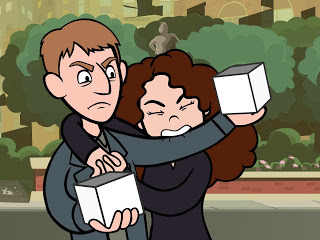
1-What do you think the most common frustrations creators have with the typical network pitching and development process?
I am lucky that in the course of my career, I've been able to work with a number of people who have done great work, and I've had shows and even pitches where the experience has been completely positive. Those moments come when the creator not only has a good idea, but understands the goals of whatever network I am working for. I, in turn, find it works best when I understand the goals and bigger vision of the creator I am working with. These moments are the ones that make a development job worth it.
On the other hand, there are certainly many times when pitches are painful -- boring, not interesting looking, or just wrong for us. But what I think the creators are feeling is just an overwhelming amount of stress. I have been taking pitches for a while now, in three different companies, and the experience is fairly consistent. The pitching process is fairly stressful for both sides! If you are on the network side, you have to walk into each pitch thinking "this might be our next show." I often sense that the creators are walking in thinking, "these people don't understand how great my project is going to be."
I always get the sense that creators and producers sense that we are holding information back -- that we know the answers or we know exactly what we are looking for and we're just not sharing it. I think they tend to have the sense that development executives are not being completely honest.
I also think that creators often feel that if they could just speak to the person in charge (if they are pitching to the rest of the department, for example,) that person would love the project and it would get picked up. Of course, a good project will generally excite anyone in the department.
Also, I think that creators sense the development executives get bored easily and are looking at their watches. This may be true some of the time. On the other hand, sometimes a minor crisis of some sort is unfolding, and then it's 2:00 and you are off to a pitch. It's impossible not to seem distracted and unfocused. Sometimes it helps to be honest about being distracted.
2-What, if anything, about this process would you change if you had the power to do so?
First, I'd find some way to make the process much less stressful. I used to joke that I was renaming the pitching process "come in and tell us about your idea," so it would sound less stressful. But the nature of the process is that it is stressful.
Also, many people who pitch are either not that great at representing their property, and many don't seem to know it well enough to make the pitch completely sound enticing. What creators can do is know their properties and be able to talk about them, rather than reading from the pitch or doing an unfocused pitch that doesn't really represent the idea. Give examples of how a show is funny, rather than saying it's going to be funny.
There are some other mistakes that creators and producers make when pitching:
- When you are pitching to a network, know what shows they produce and watch them before coming in.
- Don't think that your show needs to be exactly like the other shows on the network. They have those shows already.
- Don't insist that you know a network better than the executives sitting there. Maybe someone's trying to do something different.
- Don't tell me that other networks really like the idea and are interested. The pitching process is a lot like dating. So if you wanted to date someone, would you tell that person that many other people were interested in dating you? Or that you were interested in dating other people? Your goal is to convince the networks why your project is perfect for their network.
There are also some mistakes that executives make when taking pitches.
- Be as honest as possible. It is hard to say no, but I think most people would rather have an honest answer than to think the pitch was great and then get rejected.
- Don't act too self important. Someday, you might be on the other side of the desk, pitching to this person.
- Sometimes the pitch you are looking at isn't one you fall in love with, but perhaps this creator will be back with something better next time. You can offer feedback and/or encouragement, rather than just some terse comments.
3-What are some common problems you often see in show art in a pitch bible?
There usually isn't enough art. If you are pitching and you've only bothered to draw one drawing each of the main characters, that doesn't usually capture the feel of the show. And if the characters are posed for presentation or a character lineup, they can look pretty static. The optimum pitch, from my point of view, has rough art as well as finished art, and shows characters in a variety of situations or actions. If the show is meant to be humorous, the designs should convey that.
Many times, people will put badly drawn art in a bible. For those who do not have a background in designing characters for animation, consider hiring someone who does. The ability to illustrate is not the same as the ability to design for animation. And someone's ability to "draw just like a Disney animator" is not the same as actually being an animator. Unattractive, badly drawn or amateurish designs often ruin what otherwise might be a good idea.
4- What are some common problems you often see in plot synopsis's in a pitch bible?
Much of the time, there is too much written and it doesn't really tell much about the show. Try to be succinct, and most importantly, make sure it is an interesting read.
I always have a stack of pitches waiting, and I tend to read the shortest ones first. And if a pitch doesn't interest me right away, I don't always finish it. If a pitch isn't interesting to read, the show probably won't be much better. I should be hooked at the very beginning of the pitch.
Don't spend much of the pitch telling us how funny it will be, make it actually seem funny and that will go along way in convincing us you have the right tone.
5- What are some common problems you often see in character descriptions in a pitch bible?
Sometimes a great deal can be written about a character, and yet we still don't know much about this character. Sometimes, people have very little information about the character, othen that how funny they are going to be. Try to describe the character using terms that capture the character as if it were a real person. Make us believe this character is believable and interesting. If you want people to tune in every day to see what this character is doing, make us care about the character. When creators use very basic and bland terms to describe a character, you end up with a character who doesn't seem particularly interesting. If you need to practice, write a description of yourself, the way you'd want to be described. Most people have more than one or two character traits.
6- What are some common problems you often see in world/set-up descriptions in a pitch bible?
Creators often come up with very high concept ideas that are interesting in the pitch for a few minutes, and then just seem like they take time away from the more important parts of the shows. When someone pitches an idea where the world concept is highly stylized and everyone has names that are animals or plants or colors, I usually end up thinking that if I don't love the characters, I don't care how cleverly their world was constructed or how high their high concept was.
Sometimes a world just isn't believable and a creator's defense is often, " Well, this is my vision, in this world, dogs fly. That's how I see it." But there is often something missing or underdeveloped that makes you continue questioning the world.
7-For a first meeting with a creator, do you prefer to see a few of their ideas roughed out on two sheets before they go through the larger effort of creating a full pitch bible?
This tends to be a matter of personal preference. I prefer to see something at the very beginning, and at this point, I can tell people if the idea is interesting and a good fit for us.Then they can go back with some feedback and develop it a little more fully for us specifically. When people walk in with the foamcore-mounted characters or a finished pilot, I usually sense that they aren't open to much feedback. But on the other hand, it's very rare that someone walks in with something that works perfectly for us with no additional feedback.
8-How many pages should a pitch bible be?
I find that the initial pitch can be around five or six pages and that can include everything that I would need to see in a first draft. A typical pitch for PBS will end up fairly lengthy in the end since the show needs to be educational as well as entertaining, and the pitch also needs to be for all platforms, not just for television. But there is no need to communicate much more than the basics at first. These basics include the initial idea, the main characters, their world, the visuals, the curriculum, and five or six stories. In a final pitch, the curriculum document would be much longer, their would be an interactive/web plan and a list of advisors, as well as several other items, for example. But that just underscores the difference between a pitch for a series and a pitch that represents the idea across platforms.
9- How important is presentation in a pitch bible? For example, if the show is about furry green monsters, should the pitch bible be bound and covered in furry green fluff?
This is a matter of personal taste, I believe. I personally have no particular interest in how well the show is packaged if I don't fall in love with the basic idea. I have never picked up a show because it was packaged well for the pitch. I have wondered in some cases if the person behind the pitch might be better suited for a marketing job at times. But again, it is a matter of personal taste -- some people are driven by visuals to the point where the thought of sending something that wasn't cleverly packaged just seems wrong to them. But we tend not to pay much attention to the packaging, unless it makes the project unwieldy. (It's true, green fur doesn't file well...)
We have an ongoing joke about people who have their projects professionally bound at the printers, because the first thing we usually do is tear the binding off to have copies made.
If you want to put your time into something aesthetic, put it into making the artwork in the pitch as compelling as possible. If someone were pitching a show that had a comic book feel to it and they made the cover look like a comic book, or they did a few pages of a fake comic book that made me laugh, I'd be much more impressed.
10-Do you like to be thumbing through a pitch bible during a pitch meeting or is it a distraction?
It's a distraction to me to be thumbing through a pitch. I'd rather have someone just talk to me about the show. After all these years of taking pitches, I still have no idea if I am supposed to follow along with a pitch or not unless someone tells me specifically what I should do. It's different from pitch to pitch. The easiest for me is when someone brings art they can hold up, and then at the end, they hand out takeaway pitches for us to review.
11-What is the best way for a creator to present an animated pitch in a pitch meeting?
I prefer when someone comes in and can talk fluently about the show, can show artwork by holding up a bunch of examples, and can then capture the idea in the pitch they hand me to review. I also prefer smaller pitch meetings, as the conversation is usually better and more natural. What I hate most in a pitch meeting is when people read to me.
People usually want to know if they have to have some animation to show. They don't, but I can think of a few times when people walked in with some Flash animation that was pretty funny, and it certainly helped to get us excited about the idea. On the other hand, I can think of many more times where a weak demo killed the property for us right then.
12-How much of your development content is found or pitched to you at industry events such as MIPCOM or Kidscreen each year?
Many projects are pitched at these events, but few turn out to be right for us. I find events such as Kidscreen helpful for meeting people, but I find pitches at these events to be rushed and awkward. I find myself taking pitches from people who are not familiar with what we are looking for and are trying to pitch to as many people as possible.
In a typical pitch in my office, there would be some time to chat and learn more about the person pitching and for them to learn more about what we are looking for. The whole pitching process can be a little more relaxed, and more feedback can be shared. At Kidscreen, chances are that I am scheduled with back to back 15- and 30-minute pitches all day and after about the third or fourth pitch, my ability to concentrate is shot. At Kidscreen, I prefer taking pitches from people I'd have no chance to see during the rest of the year.
***Stay tuned for part II of my interview with Linda Simensky next week! Till then, Happy New Year!
Published on December 22, 2011 06:09
December 19, 2011
Creativity and Writer's Block
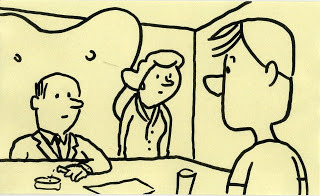
Tonight is the last day of my SVA Animation Careers class. This is the first time I've taught the class in the fall and it's been a real pleasure. In the past the only opportunity seniors had to take my class (which is a graduation requirement) was the Spring, smack in the middle of the mad rush to complete their thesis films. But whichever season the class hits, there's been one consistent variable among the students: a fear of writer's block. I get a lot of questions about that and it's a curious thing.
After the writers block questions flared up this term I asked the students, "How many of you have gotten ideas for future films you'd like to make as you've been working on your thesis films?" Every single hand in the room went up.
When you are being creative and in-process on something, ideas just seem to flow––ideas and solutions for what you're working on and stray bits of new ideas you'd like to explore in the future.
I've brought this up before, but I think I learned something about creativity by being the son of an Ad man. My dad would use his entire 4 hours-per-day commute to fill backs of envelopes and scraps of paper with scribbles of new campaigns, concepts, logos, etc. One doodle would lead to the next. But, he would have never gotten to the best stuff without having gone through that process. Quantity of ideas lead to quality. His job was just to put them all down on paper (as fast as his hand would allow) and with the understanding that the good ideas will stand out. Creativity and editing are separate stages. I think a lack of awareness in this area is what is confused with writer's block.
For example, I develop, write, and pitch proposals to networks each year, but I don't think I would be accomplishing that if I began development with my editorial hat on. To start that way would be saying, "What's the best possible idea I could think of?" That would be a sure way to kill creativity because it sets an impossible standard for any ideas to follow. A better beginning would be to ask your self: "What do I enjoy?," "What areas of interest of mine can I start with to get things flowing?"
After all is said, writer's block does exist--just ask Stephen King, who has used it as a central topic in many of his novels. No matter how comfortable we get in our brainstorm process, there will be times when we hit a wall. But, there's always options or exercises to help with that.
When I had trouble starting the storyboards for my latest film, I engaged Willy Hartland to do the storyboard (see one of Willy's original panels above), thus allowing me to focus my attention elsewhere. And, you know what? Being able to build off of what Willy did gave me the confidence to get started, even allowing me to take some of his sequences to the next level and reboard certain sections with new ideas once I figured out what I was doing. And, none of that is to fault what Willy did. I love his storyboard. But, just a like a creative brainstorm, a first storyboard is a conversation starter. Solutions and the right path to the finish emerge as you work. They don't come as easily (or at all) by staring at a blank page.
Published on December 19, 2011 04:47
December 12, 2011
Fireworks
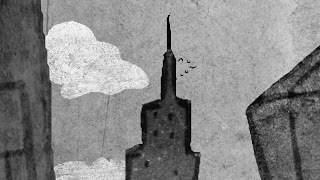
I don't know what I'll be working on professionally, year-to-year, so the only way I know if my career is on track is by making sure I'll have new experiences. All of us get some degree of new experiences through the work we do for clients, but the most reliable source for new challenges is from creative works you generate your self.
Since 2007, I've amped up the regularity by which I'm making indie films (averaging about 1 every year-and-a-half), and these projects ensure that whatever happens in the economy or to our industry, I'll make my own new experiences no matter what.
Films allow one to experiment with so many elements: the visual development that usually takes place at the beginning, the approach to the storytelling discovered in the storyboard, the pacing of the film established in the animatic, the style or design of the animation that emerges as you draw picture after picture, the audio styling that tells half your story and in ways that the visuals couldn't alone, and the fabric that is all these elements stitched together in the final product. The indie short filmmaker has final say over all these ingredients–– there's truly no other venue (as animation people) where that freedom exists.
Another thing I appreciate, is how these projects give us something positive and creative to occupy our thoughts. Sometimes while I'm walking, about to go to sleep for the night, or brushing my teeth, I'll get an idea of how to restage my scene-in-progress, or a solution for a tricky camera move, or maybe hatch a new name for the film. In short, when you're working on a personal film, there really is no time away from it. You're always thinking about it, improving it in your mind, and forever going through the creative process. I find this to be a very addictive.
Once a film is done it's like preparing to launch fireworks. Some are duds, and some explode to their full glory maybe even going beyond expectations. But, unlike fireworks, after a film burns through a two-year festival run, it still exists, building up a body of work for the filmmaker. Above and below are stills from my new short, which is only days away from completion. It's almost time to aim it away from my face and light the fuse…
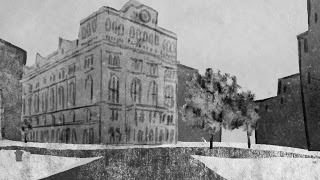
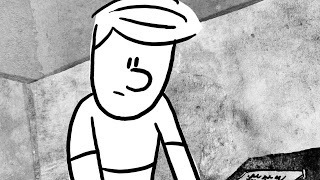
Published on December 12, 2011 04:46
David B. Levy's Blog
- David B. Levy's profile
- 1 follower
David B. Levy isn't a Goodreads Author
(yet),
but they
do have a blog,
so here are some recent posts imported from
their feed.



